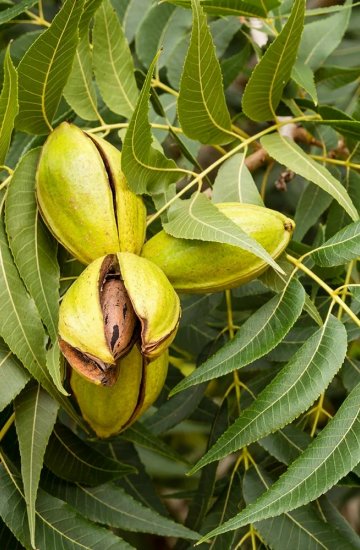
|
|
Pecan (Carya illinoinensis).
Leaves and fruits.
|
Pecan - Carya illinoinensis
The pecan (Carya illinoinensis) is a species of hickory native to the Southern United States,
from Iowa, Illinois, Indiana and Ohio south to Alabama and Mexico, being primarily found in the Mississippi River valley and the valleys of its principal tributaries.
The only major tree nut that grows naturally in North America, the pecan is considered one of the most valuable North American nut species.
The tree is cultivated for its seed primarily in the U.S. states of
Georgia, New Mexico, and Texas, and in Mexico. The seed is an edible nut used as a snack and in various recipes, such as praline candy and pecan pie. The pecan is the state nut of Alabama, Arkansas, California, Texas, and Louisiana, and is also the state tree of Texas.
Genus name (Carya) comes from the Greek word karya used for walnut trees.
Specific epithet ( illinoinensis) means of Illinois, which is part of its native range.
Common name Pecan derives from an Algonquian word variously referring to pecans, walnuts, and hickory nuts.
The pecan tree is a large deciduous tree, growing to 20–40 m
in height, rarely to 44 m. It typically has a spread of 12–23 m with a trunk up to 2 m
diamete, with a large rounded spreading crown.
It is in leaf from June to October, in flower from April to May, and the seeds ripen in October. The species is monoecious (individual flowers are either male or female, but both sexes can be found on the same plant) and is pollinated by Wind. The plant is self-fertile.
Pecan features medium green, odd-pinnate, compound leaves, with each leaf having 9-17 pointed
leaflets 5–12 cm long and 2–6 cm broad. Leaves mature to yellow green in summer, eventually turning yellow brown in fall. Non-showy, monoecious greenish yellow flowers appear in April-May, the male flowers in pendulous catkins (to 4” long) and the female flowers in short spikes. Female flowers give way to sweet, edible nuts. Each nut is encased in a thin husk which splits open in four sections when ripe in fall.
A pecan, like the fruit of all other members of the hickory genus, is not truly a nut, but is technically a drupe, a fruit with a single stone or pit, surrounded by a husk. The husks are produced from the exocarp tissue of the flower, while the part known as the nut develops from the endocarp and contains the seed.
The husk itself is aeneous, that is, brassy greenish-gold in color, oval to oblong in shape, 2.6–6 cm long, and 1.5–3 cm broad. The outer husk is 3–4 mm thick, starts out green, and turns brown at
maturity in fall, at which time it splits off in four sections to release the thin-shelled seed.
Pecan seeds are edible, with a rich, buttery flavor. They can be eaten fresh or roasted, or used in cooking, particularly in sweet desserts, such as pecan pie, a traditional Southern U.S. dish. Butter pecan is also a common flavor in cookies, cakes, and ice creams. Pecans are a significant ingredient in American praline candy. Other applications of cooking with pecans include pecan oil and pecan butter.
Pecan wood is used in making furniture and wood flooring, as well as flavoring fuel for smoking meats, giving grilled foods a sweet and nutty flavor stronger than many fruit woods.
Before European settlement, pecans were widely consumed and traded by Native Americans. As a wild forage, the fruit of the previous growing season is commonly still edible when found on the ground. Native American tribes would collect the fruit to make flour that was used as a meat substitute and a milky fermented drink called "Pow-cohicora", along with the bark and leaves made into a tea to heal ailments such as Tuberculosis.
Pecans first became known to Europeans in the 16th century. The first Europeans to come into contact with pecans were Spanish explorers in what is now Louisiana, Texas, and Mexico.[39]These Spanish explorers called the pecan, nuez de la arruga, which roughly translates to "wrinkle nut". Because of their familiarity with the genus Juglans, these early explorers referred to the nuts as nogales and nueces, the Spanish terms for "walnut trees" and "fruit of the walnut". They noted the particularly thin shell and acorn-like shape of the fruit, indicating they were referring to pecans. The Spaniards took the pecan into Europe, Asia, and Africa in the 16th century.
Source:
https://en.wikipedia.org/wiki/Pecan
https://pfaf.org/user/Plant.aspx?LatinName=Carya+illinoinensis
https://www.missouribotanicalgarden.org/PlantFinder/
PlantFinderDetails.aspx?kempercode=a852
